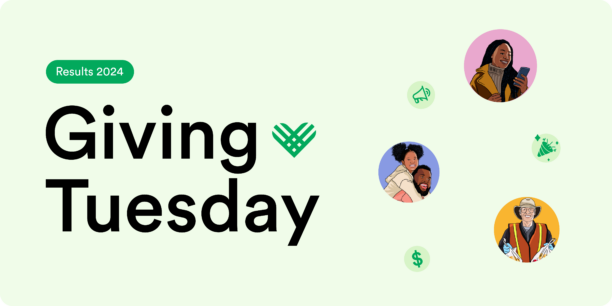Adapt and Overcome: Highlights From the 2020 Collaborative
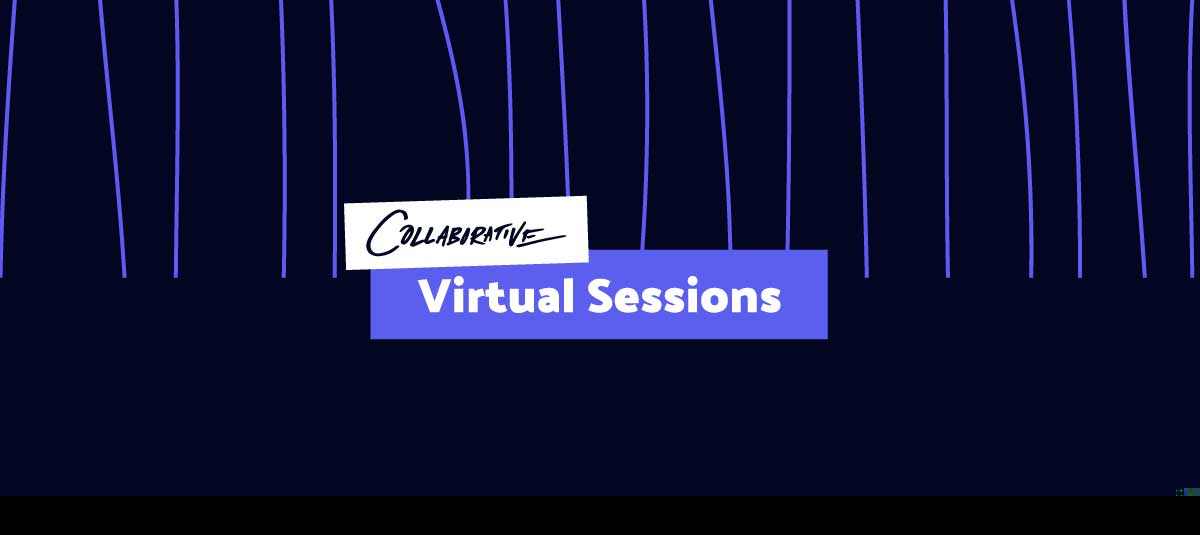
Our theme for this year’s Collaborative: Virtual Sessions was “adapt and overcome.” At first, this was in response to the COVID-19 pandemic changing nearly every aspect of our daily lives. Our team met with nonprofit practitioners to find out what you needed to move forward, and we used those insights to curate content that would help you pivot your strategy and raise much-needed funds during this unprecedented time. Much of the session content was thus focused on how to adapt to a world where online outreach, engagement, and fundraising was no longer optional, but necessary.
But COVID-19 isn’t the only pandemic the world is battling, and we didn’t think it was right to host an event focused on collaboration and supporting one another, without addressing the uprising against racial injustice.
So in the week ahead of our event, speakers updated their decks and changed their talking points, and the team found ways to highlight the current events and draw attention to the importance of the movement going on around the world.
To help facilitate conversations around how to adapt to and overcome the crises the world is facing, each session was created through the lens of how nonprofits can react, pivot, and acclimate the way that they operate to the current landscape.
Soon you’ll have the opportunity to view recordings of all of the Collaborative: Virtual Sessions, as well as over 15 bonus, exclusive recordings in the extended sessions library. We’ll also be publishing a blog post on our team’s learnings from hosting our first virtual conference, but for now, we want to share with you some of the insights that drove passionate, energetic, and motivating conversations between our speakers and over 10,000 attendees.
Collaborative Leadership for a Better World
Our opening keynote, Collaborative Leadership for a Better World, took place on day 2, but it was well worth the wait. For the first half of the hour-long session, Classy CEO and co-founder Scot Chisholm talked about our switch to a virtual event and all of the ways the industry has had to adapt since the pandemic hit the U.S.
He shared inspiring stories about how organizations like the San Francisco Ballet took swift action to adapt their business model. After more than 60% of their season was suspended due to COVID-19, the San Francisco Ballet partnered with Classy to launch an online Critical Relief Fund to keep their workforce paid and their health benefits in place, and to date they have raised more than $3 million.
We also heard about how the industry rallied around Giving Tuesday Now on May 5 to raise funds for COVID-19 relief. These stories reminded attendees that while it’s scary to throw out your playbook and try something new, those new initiatives can have results that surpass your expectations. At the same time, Scot also recognized these unprecedented times have created new, difficult challenges for many organizations that are still working to surmount them.
After Scot announced the Classy for Facebook integration launch and teased at the Connected Accounts release, he welcomed Lorna Davis, former CEO and chairwoman of Danone Wave and current Global Ambassador for the B Corps movement. Scot and Lorna discussed their experiences watching the world evolve over the last few months and how, in Lorna’s words, “This virus has demonstrated that inequality is even more powerful that we thought possible.”
As the discussion moved towards the incredible work being done to support COVID-19 relief and the inspiration our world has felt by seeing the mobilization of relief efforts, Lorna shared that, “As always, there is beauty and growth amidst what appears to be rubble.”
Empowering statements such as that were often followed by a flurry of Slack messages, with attendees quoting their favorite lines and others adding emoji reactions underlining their agreement.
This is one perk of a virtual event; attendees can directly respond and contribute to the conversation during the session they are attending. We saw so many share their thoughts, reactions, and links to supporting content or work mentioned.
https://giphy.com/gifs/eIVDl0Fx94mM1oBuZF
The GIF above was taken during the opening keynote. You can see how attendees supported one another’s ideas, answered questions, and shared their views.
Scot and Lorna’s conversation then turned to acknowledge one of the top challenges that the nonprofit industry faces: the culture of competition over collaboration, and the idea that there is only one winner in a given cause or space.
“If you can do something on your own, it’s probably not worth doing,” Lorna said. But she’s optimistic that people have been shaken awake from that thinking. “Not only is it imperative to include other people in your work, but it’s really fun!” She later touched on how it’s important to collaborate before you do anything else and that nonprofits should prioritize collaboration rather than viewing fellow nonprofits as competitors. “The ability to co-create something is so joyful, particularly when it’s something you really care about,” Lorna said.
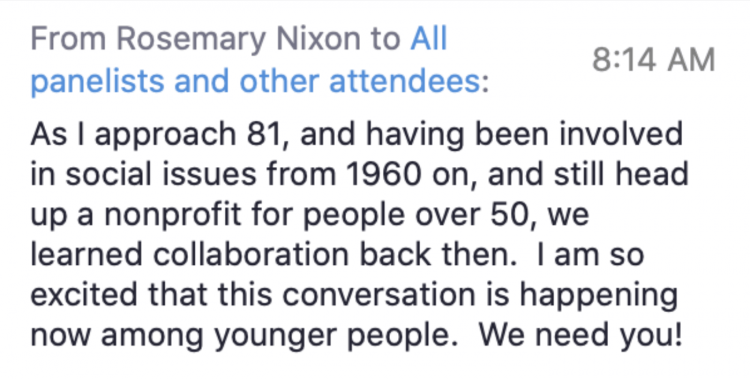
She even coined an optimistic catchphrase that was being shared throughout the communication channels and social media, “We need to change from fast and furious to calm and curious.”
Beyond collaboration with one another, both speakers agreed that the nonprofit industry needs to prioritize cross-sector collaboration. Scot posed the question, how do we make this easier to achieve? The average company doesn’t know how to collaborate with a nonprofit, and vice versa, so how do we address that?
Lorna’s response had attendees scrambling to take notes:
“The lines we create are self-created. Once we decide we won’t allow them to be barriers, the ways to break through are many. Start with a phone call. Find out who’s connected to the thing you care about the most.
She went on to explain that to elevate cross-sector collaboration, you can start by asking yourself who can help you the most. Whether it is a for-profit business, a government entity, or a fellow nonprofit—it all starts with one phone call and one connection to break through those artificial, self-made lines.
Lorna’s parting words of wisdom were around the steps you can take to evolve the collaboration within your organization:
“Your organization doesn’t run from top-down and out. It runs from the outside to the bottom and then up. Really think about who is outside of your organization that you can invite in to be a part of your mission. Inside, look at the most junior, freshest, full-of-potential young people, and how they can lift your organization up from the bottom. That’s going to keep you honest at all times—making sure outside people are invited in and junior people are invited up.
Leading Your Team Through a Crisis
We also heard tangible tips on nonprofit leadership during 3 Seasoned Leaders on How to Get Your Team Through Crisis. This panel, hosted by Lynne Gilliand of Lynne Gilliand Consulting, included Jake Wood, co-founder and CEO of Team Rubicon; Carrie Hessler Radelet, president and CEO of Project Concern International; and Dr. Shereef Elnahal, president and CEO of University Hospital.
When asked for their advice on leading a team through a crisis, the responses all revolved around honest and transparent communication. Carrie shared her three leadership principles for crisis:
- Do not wait. Have the hard conversations in real time.
- Be authentic and vulnerable. Do not let the fear of being wrong prevent you from showing up.
- Dig deep into your organization’s values. Take real actions with measurable change.
Jake tapped into his military background and shared how a U.S. Army framework, VUCA, can help you respond to chaos. VUCA stands for:
- Volatility
- Demands you have a vision for taking action and effecting change.
- Uncertainty
- Demands you have a wide understanding and see different perspectives.
- Complexity
- Demands clarity with key areas of focus that are flexible and creative.
- Ambiguity
- Demands agility in your decision-making and creating innovative solutions.
- Volatility
This framework is matched with resolution at each stage. He stated that ultimately, in times of chaos, hope cannot be the strategy—there has to be more. Over the years he has learned to prepare by building a culture that will lead and guide the team during chaos—a culture that will react by moving towards the problem, not away from it, and will lead with speed and flexibility.
Dr. Elnahal shared the critical steps needed to ensure the most important tenant in crisis response was upheld: communication. With no playbook for the pandemic, he kept true to his communication principles that afforded the trust, reliability, and authenticity needed to lead through chaos. He listed the following tactics to address communication through a crisis:
- The need for honest and revealing mass communication. This helps build trust on your front line.
- Live, dynamic communication utilizing channels like townhalls or Facebook Live. Employees will feel appreciated, connected, and encouraged by your genuine recognition.
- Physical leadership presence. It’s one thing to just communicate. You also need to show up for your team so that they know you are supporting them. This will also lead to better decision-making during difficult times.
- Structure communication for feedback and iteration by asking targeted questions.
- Empower the voices of your people on the front lines to speak up. Even to the press.
Avoiding Burnout
“I have been leading our nonprofit since its start 12 years ago and lately have really been suffering from burnout and life changes. I am so grateful for the Collaborative this year, it truly is just the re-motivation I need right now and I am sure I am not alone. Thanks for addressing the current climate and going deep. The world needs us now, more than ever.
Dr. Denise Kruszewski shared how nonprofit leaders can help support their team by leading with compassion during her session, Cultivating Strength: How to Protect Against Burnout and Build Resilience During Adversity. When discussing how to build resilience in a group, she reminded us that individual resilience is still a part of organizational resilience. “Leaders aren’t as attentive to their staff’s burnout, because they’re not attentive to their own,” Denise said.
To build resilience in ourselves we must start with being mindful. How do we do that? “A way into mindfulness is pausing,” Denise says. “An active pause that you can notice. However, mindfulness in the context of challenge can be kind of uncomfortable. And we need to talk about this barrier—our urge to avoid and our urge to fix. It’s kind of like gum, the more you try to get rid of it the messier it gets.”
In addition to self-work, she urged leaders to have the organization itself be a safe place, where someone can experience vulnerability and is met with positivity. She also advised that leaders must be willing to recalibrate expectations of themselves and others.
But what happens when a leader is leaving an organization, for whatever reason, and they need to ensure that their team is in good hands? Anne Williams-Isom, CEO of Harlem Children’s Zone (HCZ), and Kwame Owusu-Kesse, incoming CEO of Harlem Children’s Zone, shared insights around how important it is for nonprofit leaders to dedicate time to succession planning. HCZ believes strongly that to stay true to their core values, they must seamlessly transition leadership so as not to disrupt their mission, activities, or culture.
Succession planning is a long game. It needs to happen from day one and intentionally throughout your time at the organization. As a leader, you need to bring the next generation of leaders along for the ride so that they can constantly learn, ask questions, and break down rationale on decision-making.
“Succession planning isn’t something you read in a book,” Anne said. “It’s about loving our community, loving the community we serve, and taking this work very seriously because we know this organization has to be there for them.”
This is a new topic for some, but should be a priority when looking to the future, because as Kwame said, “If you are not proactively preparing someone to take over your seat, you are putting your organization in jeopardy.”
Collaboration Over Competition
Another highly anticipated session was What Are We Willing to Give Up to Stop the Nonprofit Hunger Games? Vu Lee, a renowned nonprofit blogger (NonprofitAF) and former executive director of Rainier Valley Corps, and Soraya Alexander, SVP of marketing and customer growth at Classy, logged on for a virtual fireside chat that dug into many of the complex, systemic issues that are holding nonprofits back from reaching their full potential.
The two talked about how some nonprofits are afraid to be “political” or often face pushback from their board for fear of alienating potential donors, and how the competitive nature of the industry is holding everyone back.
Vu challenged nonprofit practitioners to stop viewing fellow nonprofits as a threat with whom they are competing for donor dollars, and to instead see the industry as an ecosystem that can benefit from each other’s success. He warned against developing a shadow mission, where your mission stops being about helping people and more about, how do we keep our mission going, a mindset rooted in competitiveness instead of compassion for the people you serve. Soraya simplified it by sharing the adage, “We should be working to put ourselves out of business.”
And while radical, these actions are already happening in the sector. Vu recalled an organization that sent out a Giving Tuesday appeal saying, “We appreciate your donations, but please donate to our partner organization.” Or a nonprofit who sent a $50,000 grant to an organization in need. Upon doing this, a few of the organizations even declined and said, “We are stable right now. Could you please send this to another organization who needs it?”
He recognized that this is scary for a nonprofit who spends a lot of time trying to earn money, particularly when you feel like donors only have so much to give. To that he responded:
“We need to stop underestimating our donors. We need to be partners with them and treat them as equal partners, which means giving them all the options.
The theme of collaboration over competition came up in many of the sessions over these four days. This was not only in terms of sharing grant money with an organization in need, but also in the way that nonprofits can lend their voices and support causes that don’t fall directly within their lane.
Vu mentioned how a colleague’s board refused the idea of putting out a statement rejecting white supremacy because “[they] don’t want to be political,” but as Julia Campbell discussed in her session, The Future of Fundraising: Where Do We Go in a Post-Pandemic World, “asking for people to put money where their values are, is political.”
Julia explained further that nonprofits should be willing to “stand for something worth standing for, even if it will turn others off. The more that you do this, the more you will attract the right audience that will support you in the long run.” And isn’t that what all nonprofits need? Someone who is not just a one-time donor, or casual supporter, but a loyal, lifelong advocate for your cause.
“The worst thing we can do is be silent when voices are finally rising. Change is happening, so we have to lend our voices and our platform, however small. Ask for help if you don’t know where to start.
As a nonprofit digital marketing expert, Julia’s session was originally going to focus on tactical ways to pivot a fundraising strategy in the light of COVID-19. But she opened the event with an honest disclaimer that she made last-minute changes to her content given current events and the Black Lives Matter movement.
And while the session went beyond a list of action items, she did share tangible steps that attendees can use to inform their strategies moving forward, post-pandemic.
- Stop waiting for things to get back to normal. The new reality is looking very different, but through discomfort comes opportunity. This time represents a real reflection point for the sector. “What does this mean for us as individuals and organizations and where do we go from here? Where do we need to go? How can we get there?”
- Take some time. Fundraisers are planners and action-oriented. But what if we let things unfold and wait to discover the sustainable course of action? This takes time to process and to be thoughtful. It doesn’t mean burying your head in the sand, but rather being more intentional.
- Educate yourself and others. Embrace being uncomfortable and figure out ways to improve and equip yourself with tools to have hard conversations. “Yes, you will say the wrong thing, you will feel stupid, you will feel ashamed. Let’s get through it together because this is how we learn and grow. If someone doesn’t get it 100% right the first time, let’s be supportive.”
- Grieve the past, but release it. Let go of your pre-2020 life where going into a crowded office or supermarket is normal. Instead, look forward and ask yourself, “What is the new story that we want to emerge?”
- Do the hard work. “No one is going to tap you on the shoulder and say, ok you go lead now. It’s up to us to take charge, be visionaries and execute on our ideas.” Throw out your promotional calendar, but don’t stop communicating with your supporters. Ask donors what they want to hear, learn, and how you can help. When someone makes a donation to you, your nonprofit is a reflection of their values and ethics and your action in relation to current events matter.
- Create policies. Have the hard conversations. Ensure that everyone feels safe and heard. Look at your corporate sponsors, your supporters, your community, and ask yourself whether they truly align with your nonprofit’s values.
- Be willing to fumble and improve. “No one gets everything right the first time, but if you have the chance to genuinely get better and not hurt others, wouldn’t you take it?”
- Call out organizations for saying they believe in something, but not implementing it. The industry talks about equity, yet many nonprofit professionals aren’t paid fair living wages or paid parental leave. Many rely on unpaid internships which disproportionately allow affluent students or recent graduates to get involved in a cause because they can afford to work unpaid.
“We’re Not Going Back to Normal, We’re Going to the Other Side”
“I want you to be thinking about what it feels like to have a job where you make a difference. It’s inherently very joyful even in the toughest days.” This is how Joan Garry started the highly anticipated closing keynote on Friday afternoon. Joan is the Principal of Joan Garry Consulting and Founder of Nonprofit Leadership Lab. She is an internationally recognized champion for the nonprofit sector and highly sought-after executive coach for CEOs of some of the nation’s largest organizations.
In 1997, Joan was the executive director of GLAAD for eight years. When she started at GLAAD, the organization had $360 in the bank, 18 people on payroll, and nearly $300,000 in debt. When she left GLAAD eight years later, the organization had an $8 million revenue budget and had built a cash reserve of $1.5 million. With this experience in rising to overcome adversity, she ended our virtual conference with an emotional jolt of optimism, energy, and motivation.


Over the four days, we heard many speakers share idioms around how you have to put on your own oxygen mask first, fill your own cup, and take care of yourself to truly lead by example. The screenshot below is from Caryn York, CEO of Job Opportunities Task Force, during a Slack conversation following her session, Pandemics and Revolutions: Now Is Not the Time to Play It Safe.

Similarly, Joan’s keynote focused on how being a driven nonprofit professional who will do whatever it takes is a double-edged sword. “Over the last four months you have been on a frightening, adrenaline-driven overdrive, and you have done whatever it takes,” Joan said. “It’s time for tough love. Doing whatever it takes is not sustainable. You will not get to the other side by doing it whatever it takes.”
Joan encouraged attendees to take the word “normal” out of their vocabulary, and to stop pondering how things will be “when we go back to normal,” because:
“We’re not getting back to normal, we’re going to the other side.
“When we get to the other side you need to put away the idea of doing whatever it takes,” Joan said. “It’s time to lead with intention. You shouldn’t set your sights on surviving on the other side, you need to thrive. And the nonprofits that thrive will be focused, have a strong engaged community, try new things, and be in partnership with the board.”
Joan then shared the five things you can do right now to lead with intention.
- Practice saying no to get used to it. When you do whatever it takes, everything feels urgent—which it cannot be. Identify your strengths and where your organization most needs the work.
- Brag and ask. Your work is really important. It’s as important today as it ever was, maybe even more. “To the organizations who say, ‘we only do art …’ Stop it! Art, music, culture—you tell me we don’t need music in the world.” Brag about your work, your accomplishments, and be proud of your impact. Don’t be afraid to share asks to keep your work visible. “[When you share an ask and brag about your impact] maybe you can help others see an opportunity to see a piece of the world that they can help fix. Your ask is a gift.”
- Embrace creativity. Over the last few months, nonprofits have been heroic and will continue to be. One of the ways you accomplished what you did is by rewriting the script. By trying new things and moving quickly, suddenly you’ve accomplished what was thought impossible, and you did it in a week. “When we get to the other side you need to remember how great it was to go out on a limb and commit to spending more time there. Embrace a culture where it’s okay to pilot things. Pilots don’t always succeed, but they are the key to innovation.”
- Grow your army of ambassadors. It is time to build a culture of storytelling in your organization. Your board members should be equipped with stories you feed them. Your organization is going to need as big a posse of engaged people as possible, and they need to be fully equipped to be out there inviting people to know more and do more for your cause.
- Build excitement about your destination. A lot of people are in crisis. You need money in a hurry. Think about it like you’re on a road trip with young kids. They’re fighting or complaining or asking questions. Instead of telling them to be quiet, what if you ask them what they’re most excited about when you reach your destination?
“All of a sudden the conversation moves from bickering to ‘are we there yet?’ and this is what you need to do with your stakeholders. Right now. Instead of asking to help dig you out of the ditch, paint a picture of what will be possible on the other side. The kind of impact you can have when you get to that other side.
Think about framing your ask for help, not as a ‘save me,’ but as a bridge. If you say, ‘I want to get there,’ the donor or volunteer will agree. Ask them to be your bridge. If you do that, they’ll be asking, are we there yet? And they may just be willing to help you get there a little faster.”
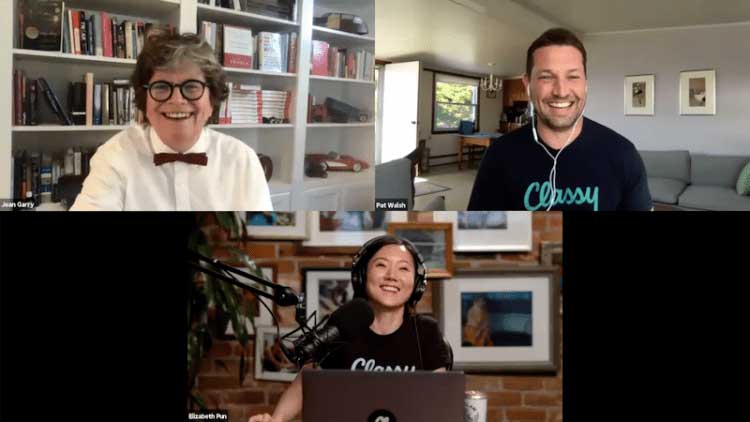
Closing keynote speaker Joan Garry, Classy co-founder and Chief Impact Officer Pat Walsh, and emcee Elizabeth Pun close out the Collaborative with smiles and a cheers.
Looking to the Future
As our co-founder Pat Walsh shared in the closing keynote, the Collaborative: Virtual Sessions was a new experience for the entire Classy team. In early March, our team weighed the pros and cons of transitioning to a virtual event. One by one, conferences around the world postponed or cancelled. We knew there would be a learning curve, with little time to adjust. Our priority to show up for our community, while staying safe, led to the decision to hold a completely virtual event, but no one anticipated that this would be our biggest and most engaging event yet.
But it was. From all of us here at Classy, thank you for attending our first-ever virtual conference. We wouldn’t have wanted to do it with any other audience in the world. We are constantly humbled by the impact of our nonprofit partners, and our collective ability to change the world for better. Thank you for your flexibility in attending this virtual event, your willingness to adapt, and your drive to overcome.
We look forward to hosting the Collaborative again next year in some capacity. Go to https://collaborative.classy.org and sign up to be the first to get details on our 2021 event.
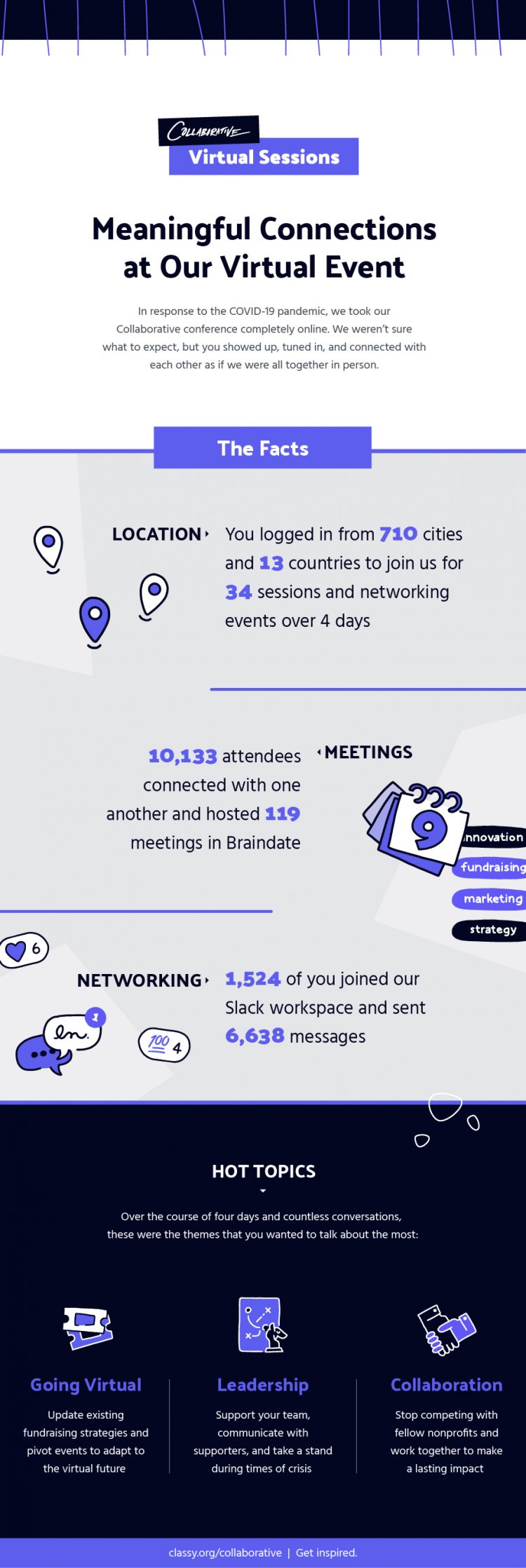

Access the Collaborative Extended Sessions
Subscribe to the Classy Blog
Get the latest fundraising tips, trends, and ideas in your inbox.
Thank you for subscribing
You signed up for emails from Classy
Request a demo
Learn how top nonprofits use Classy to power their fundraising.



